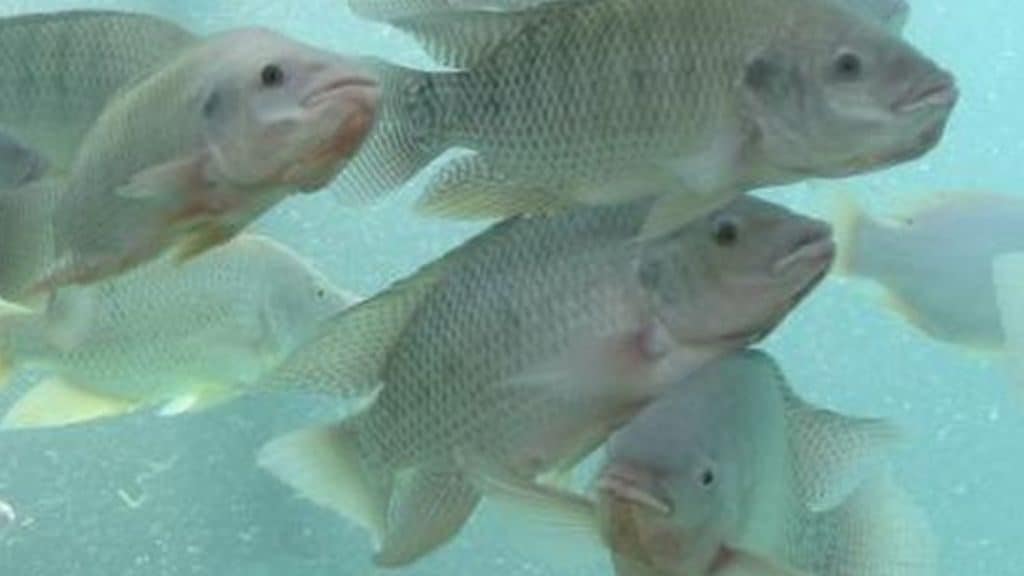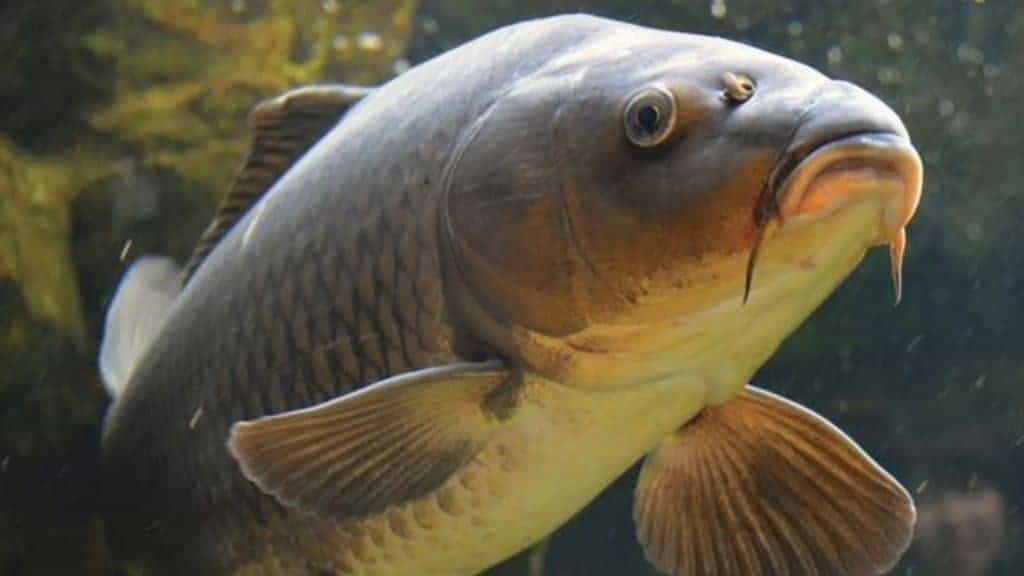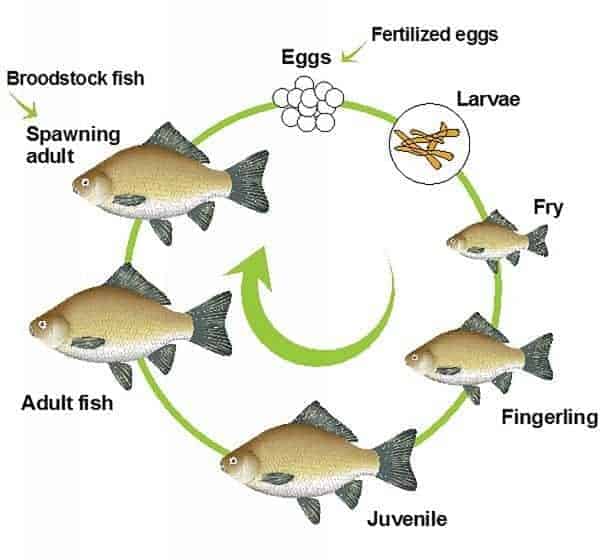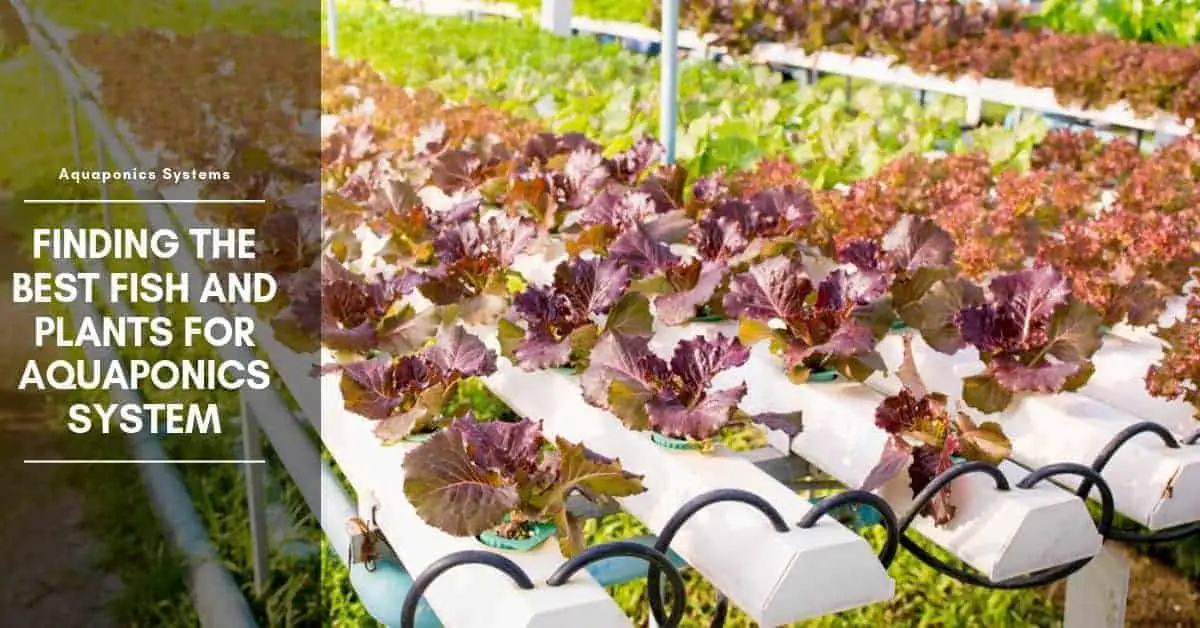A wide range of freshwater fish species like Tilapia, catfish, and trout are suitable for aquaponic use. The variety of fish that you choose will depend on the size of your system as well as environmental conditions, maximum and minimum temperatures being of particular importance. Additionally, many countries have strict regulations about which breeds of fish may be used in aquaculture in order to prevent the introduction of exotic species to local waterways.
Selecting fish
Some breeds of fish that are well-suited to aquaponic systems include the following.
Tilapia

Tilapia is one of the most popular fish for aquaculture due to their extreme hardiness and quick growth. They tolerate stress very well, are disease-resistant and thrive in aquaponic conditions, reaching their mature size in as little as 6 months. As omnivores, fish feed pellets can be partially replaced by cheaper plant foods.
Tilapia can be aggressive and cannibalistic. Additionally, they are very intolerant of cold water; while they will survive temperatures as low as 57 degrees Fahrenheit (14oC) they do not feed or grow outside of their ideal range of 68-86 degrees (20-30 oC), requiring heated water in colder climates.
Carp

Several carp species are used in aquaponic systems. Like tilapia, these fish are very tolerant of aquaponic conditions. They also have a much wider temperature tolerance, between 39 and 93 degrees Fahrenheit (4-34 oC), making them a better choice for both very hot and cold climates. Some carp are omnivorous, and they are well-suited to polyculture. Carp grow more slowly than tilapia, reaching maturity in 10-12 months.
Catfish
Catfish are another popular fish particularly well-suited to the beginning grower. They are resistant to many diseases and particularly tolerant of fluctuations in water quality, ammonia levels, and pH. Some catfish are able to breathe air, and thus will not die if water ceases to flow or the air-pump stops. Catfish thrive in densely stocked aquaponic conditions and are suitable for polyculture. Catfish prefer water temperatures above 68 degrees Fahrenheit (20oC).
Trout
Trout prefer colder temperatures than other fish, and thrive between 59-68 degrees Fahrenheit (15-20 oC), making them a good choice for temperate climates. They are a particularly popular choice for small, backyard aquaponic units for two reasons:
- They are an oily fish rich in omega-3s, making them a good choice for consumption.
- On the same rations, trout produce more ammonia than other species, thus making it possible to support more plants with fewer fish.
Trout require a high protein diet, which can be costly to maintain if not supplemented with home-grown insects or worms. Fish will prey on each other if overstocked. Additionally, trout are much less tolerant of high stocking density, low oxygen levels, poor water quality or high ammonia levels, than the other fish previously mentioned.
Other options
Other species of edible fish successfully used in aquaponics include Murray cod, perch, some species of bass, and barramundi. Fish not suitable for consumption, such as koi, feeder fish, and goldfish, can be used as well.
Sourcing fish
Fish for an aquaponic system can be sourced from aquarium or aquaculture suppliers. Fish purchased from aquaculture suppliers tend to be more economical than those from aquariums, and there are often discounts for bulk purchases. Remember when purchasing that you will not be putting the maximum stocking density into a new unit at once and that as fish grow, density will increase. If buying in bulk, an additional holding tank with a filter and air-stone may be necessary.
Fish are available at a range of life-stages from tiny fry to mature adults. Fry are too small for aquaponic use. Fingerlings are suitable and cheaper to purchase but require more care. Juvenile fish are hardier and more likely to tolerate system fluctuations, making them best suited to aquaponic use. They tend to reach a harvestable size after 6 months to a year in an aquaponic system.

It is possible to breed new stock for your aquaponic system from mature fish. However, broodstock must be kept separately from the main system to reproduce. Tilapia can be bred fairly easily on a home-scale, whereas most other species of fish are difficult to breed.
As a beginning aquaponic grower, it is best to buy fish from a reputable supplier. Purchased fish are disease-free and more likely to tolerate the fluctuations in pH, ammonia levels and temperature common to a new aquaponic unit. Once you have a seasoned aquaponics unit and some experience with raising fish to maturity successfully, then you can think about raising your own fish.
It is important to note that in almost all countries, the poaching of fish from local water sources is illegal. These fish may not be suited to the conditions of an aquaponic system; they have the potential to introduce disease and may not be fit for consumption. Using caught fish is not recommended.
Fish-friendly environments
Different fish species have slightly different environmental requirements, and it is important to learn what these are and ensure that they are met. However, there are some general considerations to take into account.
Environmental requirements
Most fish species used in aquaponics require the following environmental elements to be present in order to be able to feel happy in their living environment.
Levels of ammonia & nitrite less than 0.00005 ounces per quart (1mg/l)
This keeps the water clean and healthy and avoids any type of poisoning or discomforting in the fish.
A stable pH
While different species of fish have different preferred pH levels, there are very few which tolerate large fluctuations. In fact, rapid pH changes can cause fatality.
Tetra AquaSafe Plus, 8.45 Ounces, aquarium Water Conditioner And Dechlorinator, Model Number: 46798162681
$8.49 (as of July 13, 2024 11:01 GMT +03:00 - More infoProduct prices and availability are accurate as of the date/time indicated and are subject to change. Any price and availability information displayed on [relevant Amazon Site(s), as applicable] at the time of purchase will apply to the purchase of this product.)API TAP WATER CONDITIONER Aquarium Water Conditioner 16-Ounce Bottle
(as of July 13, 2024 06:40 GMT +03:00 - More infoProduct prices and availability are accurate as of the date/time indicated and are subject to change. Any price and availability information displayed on [relevant Amazon Site(s), as applicable] at the time of purchase will apply to the purchase of this product.)API STRESS COAT Aquarium Water Conditioner 4-Ounce Bottle (85B)
40% OffProtection from direct light
Although fish prefer to have some, low-level light, protection from direct sunlight is necessary in order to prevent algae-growth and temperature fluctuations.
High oxygen levels
High levels of dissolved oxygen in the water are required for fish to breathe. Ensure that water is aerated (two air-stones or pumps for every 9 cubic feet (1m3) of water) and that fish are not overstocked. Discourage algae growth and remove sediment from the water, as these can both consume oxygen.
Protection from predation
Fish suffer from stress and need protection from predators such as wild animals, birds and domestic pets. Additionally, large fish of most breeds will prey on smaller fish; do not mix fish of different ages, or with large variations in size.
Fish tanks
Any opaque or translucent container can make an acceptable fish tank. Choose a tank that is large enough to allow you to expand your system to include more grow beds once it is fully stocked – at least 9 cubic feet (1m3). Fish tanks should not be less than 130 gallons (500L).
Ensure your fish tank allows a little light, and that covers are not air-tight, allowing oxygen to contact the water surface. Water pipes should be screened to prevent fish from becoming trapped. Fish tanks should have at least one air-pump and two is recommended.
Stocking densities
Stocking density is important for fish health, as it impacts on environmental factors as well as fish stress levels. In a small-scale aquaponic system, a lower stocking density is recommended as filtration and oxygenation systems are less powerful than those used commercially. No more than 20 adult fish per 160 gallons (1000 liters) of total water is recommended.
Fish care
If you maintain system health and cleanliness, which is important for all three elements of an aquaponics unit, fish themselves will need minimal specific care. The most important thing you will have to do is feed them!
Moving fish
When introducing fish to a new environment, sudden changes to elements such as pH and water temperature can cause death. Whether you are adding new fish to your unit, or moving fish from one tank to another, introduce changes slowly.
Test both the fish’s current environment and the destination. Then gradually alter conditions in the holding tank or container over 24-48 hours until they are the same as the destination. Changes can usually be achieved by slowly replacing the water in the holding tank with water from the destination. Once the environment of both places is the same, fish can be moved to a new location.
Particular care needs to be taken when placing new fish into an already stocked aquaponic unit. Place fish in a holding tank for 5-7 days if possible, monitoring closely for signs of disease, before introducing them to your system. Follow the procedure outlined above for introducing environmental changes.
Choosing a feed
Fish have particular dietary requirements for health and optimum growth. These requirements include a range of vitamins and minerals, as well as the correct proportions of proteins, fats, and carbohydrates. Requirements vary throughout their life cycle, with growing fish requiring more protein than adult fish.
The easiest feeding option for home aquaponics is to purchase a pelletized fish food. It is possible to make homemade feed, but it’s unlikely to meet all the needs of growing fish. Most commercial fish food, on the other hand, is a “complete” feed, meaning that it contains all of the elements that fish need to grow.
When choosing a fish feed, consider the following questions to determine exactly what type of fish feed you require:
Is your fish species omnivorous or carnivorous?
This will affect the amount of protein the food needs to contain.
Is there a species-specific feed available?
Using species-specific food will ensure optimum growth.
How large is your fish?
Mature fish can eat pellets up to 1/5 of an inch (5mm), whereas fingerlings require a smaller grade. It is possible to buy feed sized for different life-stages, or larger feeds can be crushed to suit fingerlings.
What are the feeding habits of your fish species?
Fish feed is designed to either float or to sink, in order to suit the feeding habits of different species.
Feeding fish
Use the freshest feed possible and never use feed which is damp or moldy. The amount of feed given to fish will depend on the species and the age of your stock. Fingerlings eat about 10% of their body-weight per day, and this percentage decreases as fish grow. Additionally, appetite is affected by stress and temperatures.
After estimating the amount of food needed based on species, size and number of fish, monitor your fish when eating: all of the food should be consumed within 20 minutes. If a lot is left over, this is likely to clog filters and lead to unwanted bacteria, indicating that the fish should be fed less. Most varieties of fish prefer to eat in the morning or evening, and feeding can take place up to 3 times per day.
Monitoring fish
Fish require a little more care than plants, as they are living creatures that respond quickly to any type of change in their surroundings. Monitoring of your fish is essential to keep them happy and well-nourished. Let’s look at what we need to check up on regularly.
Health
Fish health is dependent on environmental conditions. Therefore, monitoring pH, water temperature, ammonia, and nitrites, gives a good indication of fish health. In an environment that meets their requirements, does not provoke stress and where the purity of anything added to the system is maintained, fish are unlikely to suffer from the disease.
Stress levels
Stress can cause health problems and fatalities in fish. Fish are susceptible to stress caused by less than ideal environmental conditions such as those discussed previously, as well as emotional stress and stress caused by environmental changes. Stress may present as poor appetite, changes to behavior, physical injuries, aggressiveness, and death.
Environmental stress can be avoided by closely monitoring ammonia and nitrite levels, ensuring adequate oxygenation, and avoiding overstocking. Emotional stress can be managed by keeping the fish tank shaded and preventing sudden exposure to light and noise. Handle fish as little as possible, and do so in the dark where practical. Environmental changes on a systemic level, such as pH and temperature fluctuations, can be avoided through good system management and regular monitoring.
Harvesting
Species, as well as a range of environmental factors such as temperature, determine fish growth rates. Fish can be harvested for use at any size. Once they reach their mature size, they will also have reached sexual maturity and exhibit behavioral changes including increased aggression. Broodstock should be removed from the aquaponic unit at this time. The remaining stock should be purged for 2-3 days and harvested.
Finding plants that love those fish
Most vegetable plants are suitable for aquaponic production. The varieties which you choose will depend on your system design and environmental conditions, as well as your preferences. Plants are easily the hardiest component of an aquaponic system and thrive in a balanced unit.
Selecting plants
Most commonly grown vegetable and herb plants will perform well in an aquaponic system. Leafy green herbs, such as lettuces, are a favorite. These plants respond well to high-nitrogen levels and low micro-nutrients, making them an excellent choice for newly established aquaponic units. They produce prolifically and quickly. Legumes and brassicas have slightly higher nutrient requirements than leafy green herbs.
Fruiting plants have more nutrient requirements again and are therefore better suited to established and well-stocked aquaponic units. They perform well in aquaponic conditions but have more nutrient requirements than leafy greens. In particular, potassium and calcium are required for fruiting and may need to be added to the system where deficiencies are indicated.
While shallow-rooted root crops such as radish and beets can perform well in Media Beds, carrots, potatoes, and other deep-rooted root crops are not suited to the system. Nor are large fruiting plants like pumpkins and melons.
Sourcing plants
Seedlings can be propagated at home or sourced from a commercial supplier. Wherever possible, plants should be raised in a soil-less medium to prevent disease and sediment from entering the system.
Seedlings can be purchased cheaply and commercially grown plants are often hardier than self-propagated ones. However, the varieties available commercially can be limited and, unless you are using a hydroponic supplier, the plants will likely be grown in a soil-based potting mix.
While it is not ideal to use plants propagated in soil, as it can contain unwanted bacteria and pathogens, they can flourish with the correct treatment. Before planting, flush the roots with water to remove all the soil particles. Once no soil is visible, briefly rinse the root system in a bleach and water mixture (1 part to 100), or another sterilizing mixture, before rinsing again in freshwater. This treatment can lead to higher levels of transplant shock in seedlings but is the only reliable method for removing unwanted soil and diseases.
It is fairly simple to propagate your own seeds in stone wool plugs or small punnets. This option is more economical than buying plants but does require forward planning and regular watering.
Plant-friendly environments
If environmental requirements in an aquaponic system are suitable for fish and nitrifying bacteria, they will also allow plants to thrive, with only a few exceptions.
Temperature
Plants are more tolerant of ambient temperatures than the other elements of an aquaponic system. However, they do suffer when water temperatures, and therefore the temperature of their roots, becomes very warm. Lettuce, in particular, will die or bolt to seed if water temperatures top 73 degrees (23oC). Therefore, plant choice may also be influenced by the water temperature of the system as dictated by fish species.
pH level
Fluctuations in pH influence the nutrients that plants can absorb. Therefore symptoms of nutrient deficiency in plants can be indicative of a pH issue. Plants perform best in a slightly acid environment, with a pH of 6 to 7. However, the needs of bacteria and fish are more important in this regard and most plants have some tolerance of pH outside this ideal range.
Sunlight
Most vegetable plants require between 2 and 6 hours of sunlight per day. Artificial light is also acceptable.
Plant care
Plants grown in an aquaponic system tend to be fairly hardy. Monitoring the system generally and maintaining environmental conditions should prevent most problems.
Planting methods
In an NFT tube, plants which readily form water roots (leafy green herbs) can be placed directly into the cups or nets, but generally, plants are grown in stone wool plugs or pellets to better support their root structure. Plugs and pellets can also be placed directly into the cups.
If using growing media, transplant your plants into the growing tray as you would a pot, gently teasing the roots out to their maximum length. Ensure that they are planted to the same depth as they were in their original containers. If plants are raised in plugs or pellets, these can be planted straight into the media.

Hi, my name is Sean, and I’m the primary writer on the site. I’m blogging mostly about freshwater and saltwater aquariums, fish, invertebrates, and plants. I’m experienced in the fishkeeping hobby for many years. Over the years I have kept many tanks, and have recently begun getting more serious in wanting to become a professional aquarist. All my knowledge comes from experience and reading forums and a lot of informative sites. In pursuit of becoming a professional, I also want to inspire as many people as I can to pick up this hobby and keep the public interest growing.
Read more about Sean.
Please join also my Facebook group.



















